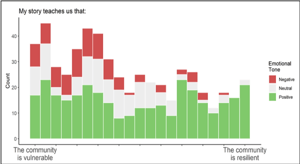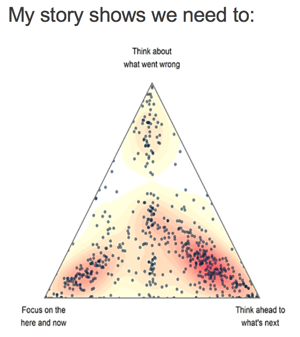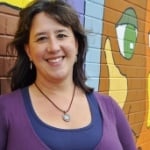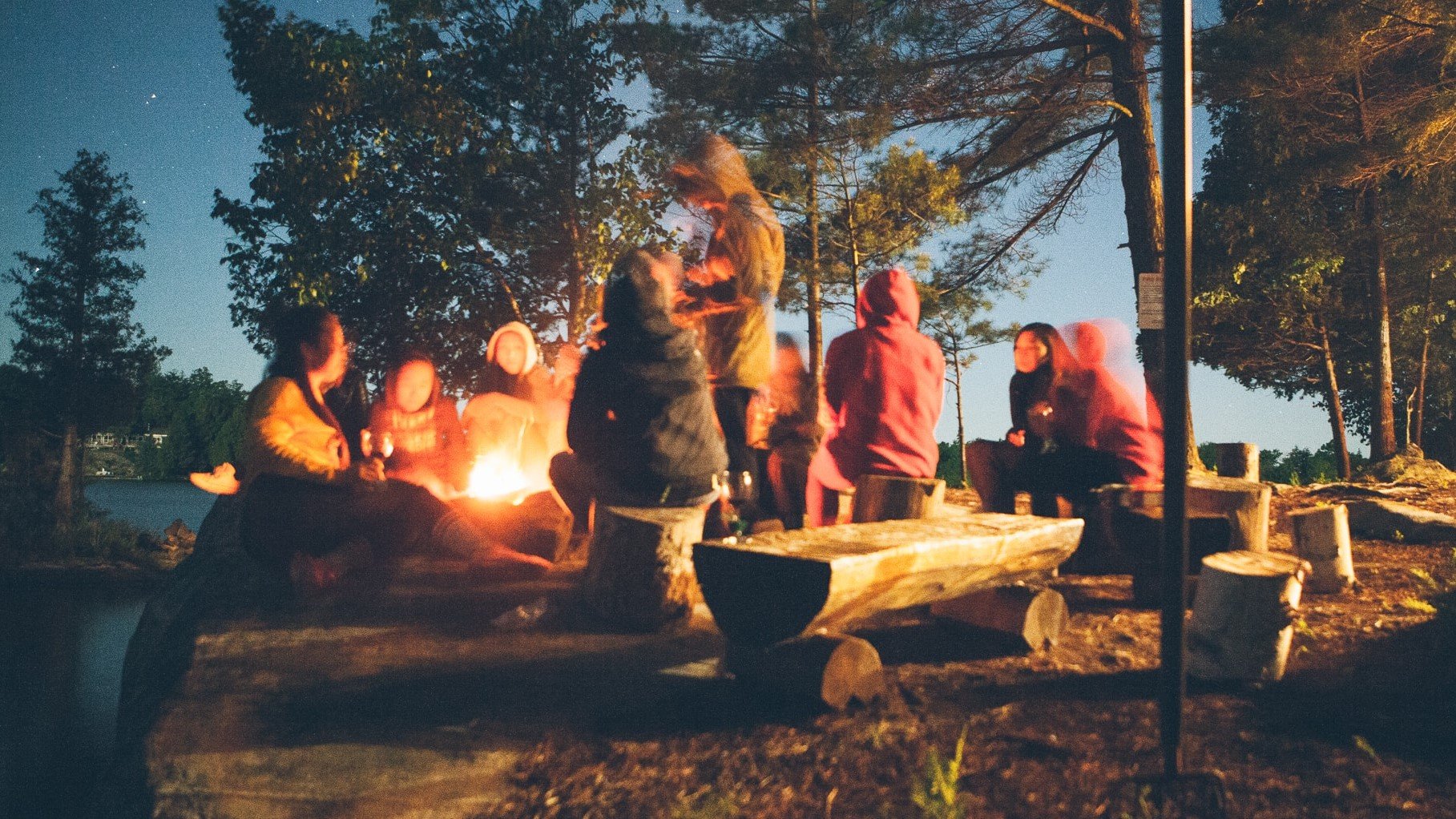I have long been curious about the different roles that stories and narratives can play in the work of community change. I have seen how one individual story, powerfully told, has the power to instantly engage people and offer clarity and understanding of a complex issue in ways that well-researched data and analysis alone cannot accomplish.
I know that communities, like individuals, have stories about themselves that can both limit and inspire their hopes for the future. These community narratives – about who we are; how things go; what’s possible for us here – shape collective thinking and can play a role in determining the future. Uncovering current shared community narratives and inviting community members to co-create new, compelling narratives that are rooted in their shared hopes for the future can be a powerful lever for community change.
I also know how challenging it can be to capture the wisdom and insights shared through people’s stories in ways that can help inform change efforts. This is often seen when organizational and community leaders come together to work collaboratively. One reason for that is that while individuals and communities speak in stories, systems typically respond to patterns and themes. Unless work is done to identify the common themes and patterns across people’s individual stories, system leaders often understandably struggle to know how to respond and act to the stories that are shared with them. This sensemaking is also invaluable to individual storytellers as well. Without access to the patterns and themes that unite the stories of many individuals, a storyteller's ability to contribute to systems change efforts, runs the risk of being tokenistic or unrealistic – as if the storyteller is being asked to speak on behalf of all people with lived experience.
 Recently I was excited to learn about a new story-telling initiative being championed by Palm Health Foundation’s Healthier Together communities and BeWellPBC along with Pathways 2 Prosperity and the EJS Project – two other area non-profits in Palm Beach County Florida. Together, these groups are inviting residents to share their own stories of the experience and impact of COVID-19 online. What makes this initiative unique is the use of an online crowdsourcing research tool known as SenseMaker® that offers the capability of tracking and sharing the impact of the COVID-19 pandemic on the lives of Palm Beach County residents.
Recently I was excited to learn about a new story-telling initiative being championed by Palm Health Foundation’s Healthier Together communities and BeWellPBC along with Pathways 2 Prosperity and the EJS Project – two other area non-profits in Palm Beach County Florida. Together, these groups are inviting residents to share their own stories of the experience and impact of COVID-19 online. What makes this initiative unique is the use of an online crowdsourcing research tool known as SenseMaker® that offers the capability of tracking and sharing the impact of the COVID-19 pandemic on the lives of Palm Beach County residents.
The stories being collected across the community are publicly shared, analyzed and updated daily. The results are being used to keep the community informed and to also mobilize a coordinated response how and where it’s needed the most. As a results of the stories, Palm Health Foundation established The Neighbors Helping Neighbors Fund. This fund puts small grants directly into the hands of residents who are struggling to pay their rent, access food, receive medical treatment and more and is intended to help our neighbors recover, rebuild and plan for the future. The topic of community mental health has also emerged as a possible interest area for funding.
 One of the powerful aspects of this online story collection effort is that those who contribute stories are invited – through a series of follow-up questions about there story – to interpret the personal significance of their story. As illustrated in the visuals, this provides immediate access to another level of analysis and understanding that can be used for more focused community dialogues and exploration.
One of the powerful aspects of this online story collection effort is that those who contribute stories are invited – through a series of follow-up questions about there story – to interpret the personal significance of their story. As illustrated in the visuals, this provides immediate access to another level of analysis and understanding that can be used for more focused community dialogues and exploration.
“SenseMaker® is giving us a window into both the personal and community-wide impact of COVID-19 in a unique way that reveals patterns in real-time about the effectiveness of response efforts,” said Patrick McNamara, president and CEO of Palm Health Foundation. “Collecting qualitative data has been used by big business to provide valuable consumer insight and now we are applying it to gain valuable insight into the most traumatic experience our county has ever faced in recent history.”
Palm Beach County’s trail-blazing work with community storytelling and sense-making reminds me of a story about the Afari, a nomadic tribe in Ethiopia, and their belief in their practice of sharing dagu that I remember reading about in Getting to Maybe: How the World is Changed. Dagu means “information” but it is much more than just data. When Afari families meet, they sit down to talk and listen to each other, usually for hours. The Afari believe it is their sacred responsibility to listen and share dagu. To survive in their harsh and ever-changing environment, dagu enables the Afari to rely on all members of their community to be sensitive and aware of emerging patterns – both natural and social. They credit the practice as dagu as the secret to their longevity. While the Afari do not believe that they can control the patterns unfolding in the world around them, they do know that if they can understand these patterns deeply, they can work within them and potentially nudge them or influence them in positive directions.
The response from residents has been extremely positive and the network of community partners is expanding to accelerate hyper local story collection networks. The SenseMaker® Initiative is offering the people of Palm Beach County an opportunity to rediscover the power of sharing their stories as their own way of practicing dagu. Andy McAusland, Palm Health Foundation’s Director of Grants and Evaluation and a key champion of this initiative captures the essence of its impact well. “It would seem we've come full circle. Storytelling – one of the most ancient tools communities have used to make sense of the world – will be amongst the most important tools to master as the complexity of the world and pace of change increases exponentially.” As Palm Beach County’s Sensemaker Initiative is demonstrating, their capacity to use stories for shared sensemaking is offering powerful insights for how community members can work with and nudge the emerging patterns in the world around them to create greater health, equity and safety for all.
LEARN MORE:
- Visit the Palm Health Foundation website
- Learn more about the Healthier Together Initiative, BeWellPBC, Pathways 2 Prosperity and the EJS Project
- View the Palm Health Foundation’s SenseMaker® Story Collection Project Data
- Learn more about SenseMaker®





